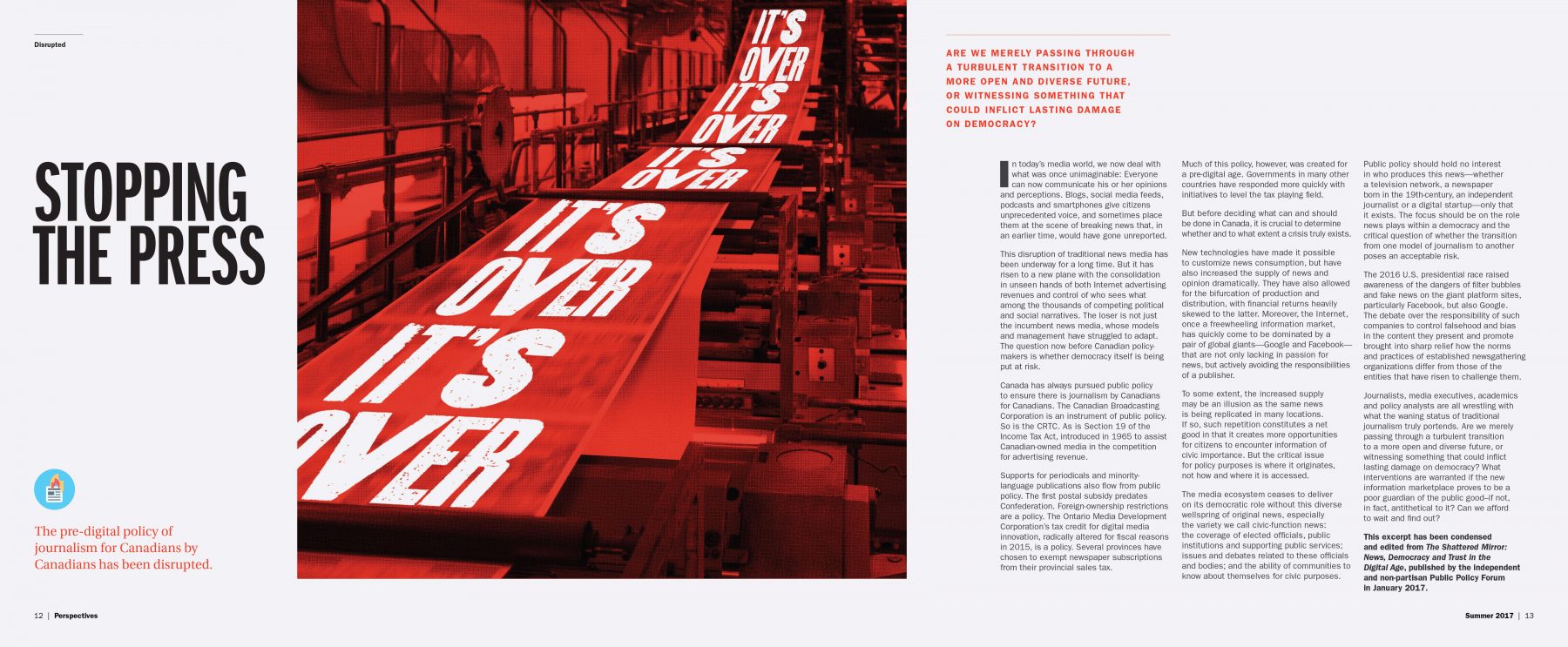- CEOCap
- Jaime Watt’s Debut Bestseller ‘What I Wish I Said’
- Media Training
- The Push Back
- Internship program
- Update Your Profile
- Homepage
- It’s time for a change
- It’s time for a change
- Kio
- Ottawa
- Art at Navigator
- Navigator Limited Ontario Accessibility Policy
- Virtual Retreat 2020 Closing Remarks
- COVID-19 Resources
- Offices
- Navigator Sight: COVID-19 Monitor
- Navigator Sight: COVID-19 Monitor – Archive
- Privacy Policy
- Research Privacy Policy
- Canadian Centre for the Purpose of the Corporation
- Chairman’s desk
- ELXN44
- Media
- Perspectives
- Podcasts
- Subscribe
- Crisis
- Reputation
- Government relations
- Public affairs campaigns
- Capital markets
- Discover
- studio
- How we win
- What we believe
- Who we are
- Careers
- Newsroom
- AI
- Empower by Navigator
- Environmental responsibility

The pre-digital policy of journalism for Canadians by Canadians has been disrupted.
ARE WE MERELY PASSING THROUGH A TURBULENT TRANSITION TO A MORE OPEN AND DIVERSE FUTURE, OR WITNESSING SOMETHING THAT COULD INFLICT LASTING DAMAGE ON DEMOCRACY?
In today’s media world, we now deal with what was once unimaginable: Everyone can now communicate his or her opinions and perceptions. Blogs, social media feeds, podcasts and smartphones give citizens unprecedented voice, and sometimes place them at the scene of breaking news that, in an earlier time, would have gone unreported.
This disruption of traditional news media has been underway for a long time. But it has risen to a new plane with the consolidation in unseen hands of both Internet advertising revenues and control of who sees what among the thousands of competing political and social narratives. The loser is not just the incumbent news media, whose models and management have struggled to adapt. The question now before Canadian policy- makers is whether democracy itself is being put at risk.
Canada has always pursued public policy to ensure there is journalism by Canadians for Canadians. The Canadian Broadcasting Corporation is an instrument of public policy. So is the CRTC. As is Section 19 of the Income Tax Act, introduced in 1965 to assist Canadian-owned media in the competition for advertising revenue.
Supports for periodicals and minority- language publications also ow from public policy. The rst postal subsidy predates Confederation. Foreign-ownership restrictions are a policy. The Ontario Media Development Corporation’s tax credit for digital media innovation, radically altered for scal reasons in 2015, is a policy. Several provinces have chosen to exempt newspaper subscriptions from their provincial sales tax.
Much of this policy, however, was created for a pre-digital age. Governments in many other countries have responded more quickly with initiatives to level the tax playing field.
But before deciding what can and should be done in Canada, it is crucial to determine whether and to what extent a crisis truly exists.
New technologies have made it possible to customize news consumption, but have also increased the supply of news and opinion dramatically. They have also allowed for the bifurcation of production and distribution, with nancial returns heavily skewed to the latter. Moreover, the Internet, once a freewheeling information market,
has quickly come to be dominated by a pair of global giants—Google and Facebook— that are not only lacking in passion for news, but actively avoiding the responsibilities of a publisher.
To some extent, the increased supply may be an illusion as the same news
is being replicated in many locations. If so, such repetition constitutes a net good in that it creates more opportunities for citizens to encounter information of civic importance. But the critical issue for policy purposes is where it originates, not how and where it is accessed.
The media ecosystem ceases to deliver on its democratic role without this diverse wellspring of original news, especially the variety we call civic-function news: the coverage of elected of cials, public institutions and supporting public services; issues and debates related to these of cials and bodies; and the ability of communities to know about themselves for civic purposes.
Public policy should hold no interest in who produces this news—whether
a television network, a newspaper born in the 19th-century, an independent journalist or a digital startup—only that it exists. The focus should be on the role news plays within a democracy and the critical question of whether the transition from one model of journalism to another poses an acceptable risk.
The 2016 U.S. presidential race raised awareness of the dangers of lter bubbles and fake news on the giant platform sites, particularly Facebook, but also Google. The debate over the responsibility of such companies to control falsehood and bias in the content they present and promote brought into sharp relief how the norms and practices of established newsgathering organizations differ from those of the entities that have risen to challenge them.
Journalists, media executives, academics and policy analysts are all wrestling with what the waning status of traditional journalism truly portends. Are we merely passing through a turbulent transition
to a more open and diverse future, or witnessing something that could in ict lasting damage on democracy? What interventions are warranted if the new information marketplace proves to be a poor guardian of the public good–if not, in fact, antithetical to it? Can we afford to wait and nd out?
This excerpt has been condensed and edited from The Shattered Mirror: News, Democracy and Trust in the Digital Age, published by the independent and non-partisan Public Policy Forum in January 2017.
